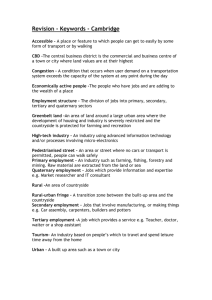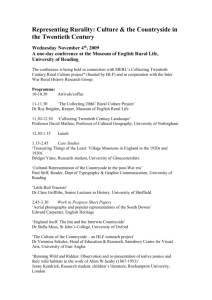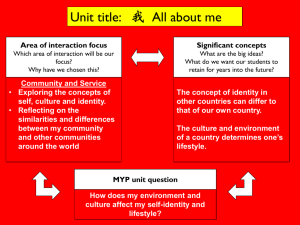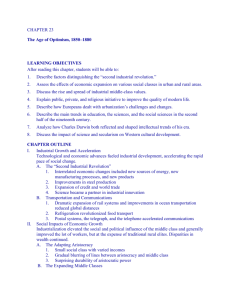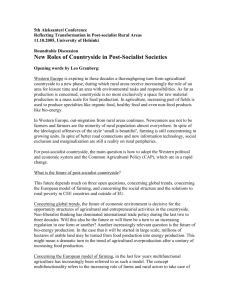Landscape and Englishness lecture notes Introduction
advertisement
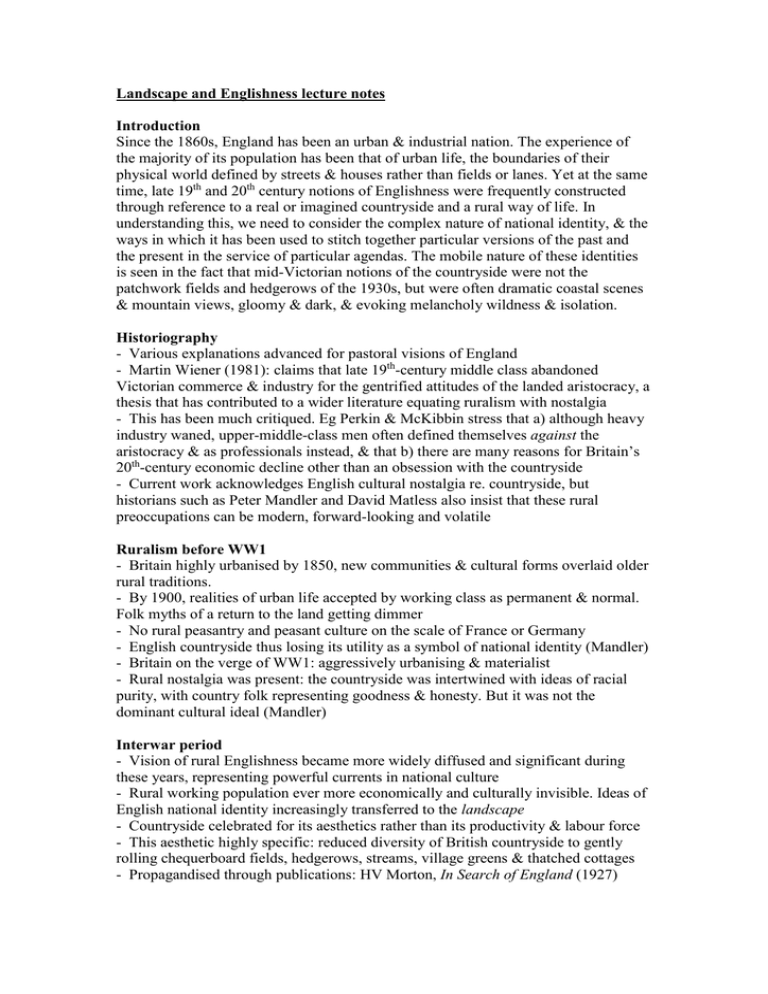
Landscape and Englishness lecture notes Introduction Since the 1860s, England has been an urban & industrial nation. The experience of the majority of its population has been that of urban life, the boundaries of their physical world defined by streets & houses rather than fields or lanes. Yet at the same time, late 19th and 20th century notions of Englishness were frequently constructed through reference to a real or imagined countryside and a rural way of life. In understanding this, we need to consider the complex nature of national identity, & the ways in which it has been used to stitch together particular versions of the past and the present in the service of particular agendas. The mobile nature of these identities is seen in the fact that mid-Victorian notions of the countryside were not the patchwork fields and hedgerows of the 1930s, but were often dramatic coastal scenes & mountain views, gloomy & dark, & evoking melancholy wildness & isolation. Historiography - Various explanations advanced for pastoral visions of England - Martin Wiener (1981): claims that late 19th-century middle class abandoned Victorian commerce & industry for the gentrified attitudes of the landed aristocracy, a thesis that has contributed to a wider literature equating ruralism with nostalgia - This has been much critiqued. Eg Perkin & McKibbin stress that a) although heavy industry waned, upper-middle-class men often defined themselves against the aristocracy & as professionals instead, & that b) there are many reasons for Britain’s 20th-century economic decline other than an obsession with the countryside - Current work acknowledges English cultural nostalgia re. countryside, but historians such as Peter Mandler and David Matless also insist that these rural preoccupations can be modern, forward-looking and volatile Ruralism before WW1 - Britain highly urbanised by 1850, new communities & cultural forms overlaid older rural traditions. - By 1900, realities of urban life accepted by working class as permanent & normal. Folk myths of a return to the land getting dimmer - No rural peasantry and peasant culture on the scale of France or Germany - English countryside thus losing its utility as a symbol of national identity (Mandler) - Britain on the verge of WW1: aggressively urbanising & materialist - Rural nostalgia was present: the countryside was intertwined with ideas of racial purity, with country folk representing goodness & honesty. But it was not the dominant cultural ideal (Mandler) Interwar period - Vision of rural Englishness became more widely diffused and significant during these years, representing powerful currents in national culture - Rural working population ever more economically and culturally invisible. Ideas of English national identity increasingly transferred to the landscape - Countryside celebrated for its aesthetics rather than its productivity & labour force - This aesthetic highly specific: reduced diversity of British countryside to gently rolling chequerboard fields, hedgerows, streams, village greens & thatched cottages - Propagandised through publications: HV Morton, In Search of England (1927) - Countryside became synonymous with peacefulness, harmony, decency, honesty and order, and with the ‘genius’ of the British constitution - But values associated with countryside (controlled, disciplined, polite, reticent etc) largely those that the urban and suburban middle classes saw in themselves - Locating this rural fantasy in SE England corresponded to the power base of the middle-class professions (law, finance, civil service, medicine etc): not the countryside of the aristocracy and country house set - Interwar Tory prime minister Stanley Baldwin used a language of rural Britishness to appeal to his middle-class constituency - Visions of Englishness/Britishness, its past & present, thus shaped in the interests & image of powerful social groups. Image of SE England used to symbolise the nation - Countryside imagery also a reaction to industrialised horrors of WW1: a more inward looking, domestic, less aggressively militaristic/imperialistic identity Middle-class recreation & leisure in countryside - 1920s/1930s: greater use of countryside by middle class for leisure & recreation - Guide books to rural England, country-based tourism of guest houses and hotels -- Fashions for cycling, rambling, camping. Youth Hostel Association & the Ramblers Association established during these years. - Significant rise of motoring among the interwar middle class also crucial here - Rural leisure reconfigured around petrol engine & new and better roads - Hard to characterise these activities as a purely nostalgic approach to countryside - Once tamed & aestheticised, rural Britain became an enjoyable adjunct to modern, urban life, and a useful tool in defining the boundaries and meanings of class Council for the Preservation of Rural England (CPRE) - CPRE founded in 1926. Not simply nostalgic: sought to ally preservation and tradition with orderliness & modernity - Held contemporary view that middle-class expertise gave it authority to preside over and transform the landscape, setting standards for what it believed to be good/ordered/beautiful, and what was instead chaotic/ugly/horrible - Power of CPRE limited interwar, but at times seems to have viewed the countryside as a national estate that should be centrally managed - For CPRE particular countryside activities become associated with citizenship: eg rambling not simply physically beneficial but morally improving (& allied to far right concerns with national/racial fitness) - But the question of who was entitled to this citizenship was viewed along class lines - WW2, with its transformation of agriculture, evacuation etc, greatly increased the scope for this kind of professional expertise and its cultural agendas Suburbia - Development of suburbia a profound alteration to interwar landscape. 4M+ new houses were built, development flowed out largely unregulated into the countryside - Suburbanisation brought the city into the country rather than vice versa. Little in common with landownership structure of the countryside or with village life - Its economic lifeline typically a transport system with access to white-collar jobs - For CPRE, and intellectual opinion in general, suburbia was an anathema: especially unplanned ribbon developments along arterial roads - A cultural villain: grey, revolting, repellent, sham, impertinent, disordered - Anxiety that suburbia blurred distinctions of class and status - Upper middle class identified suburbia as home of non-professional/commercial lower middle class, & poured scorn on what they described as the cheap, sham rustic embellishments of suburban ‘Tudorbethan’ architecture - Nonetheless, using their homes to refer to a rural/pre-industrial past was something that the middle class in general did to differentiate itself from the urban working class Countryside & the working class - 19th century urbanisation generated middle- & upper-class concerns re. the masses: virtuous, healthy peasantry supposedly turning into urban degenerates etc - Vision of Englishness as rural purposely excluded inner city life & its threateningly democratised working class residents - Criminality & delinquency associated with city. Inner-city people visiting the countryside often seen as badly behaved trespassers - Middle-class country ideal also far removed from the ‘vulgar’, ‘brash’, ‘noisy’ crowds of working-class seaside holidays - Portrayal of countryside, and thereby England itself, as defined by slow harmonious & organic evolution rather than violent rupture used by middle class to define working-class socialists & communists as un-English and irresponsibly destructive - Allowed the middle class to present itself as the nation’s guardian, and to present the inner city working class as selfish & a potential threat - Countryside recreation could, though, take a more left wing form: eg the mass ‘right to roam’ trespass on privately owned land at Kinder Scout, Derbyshire, in 1932
